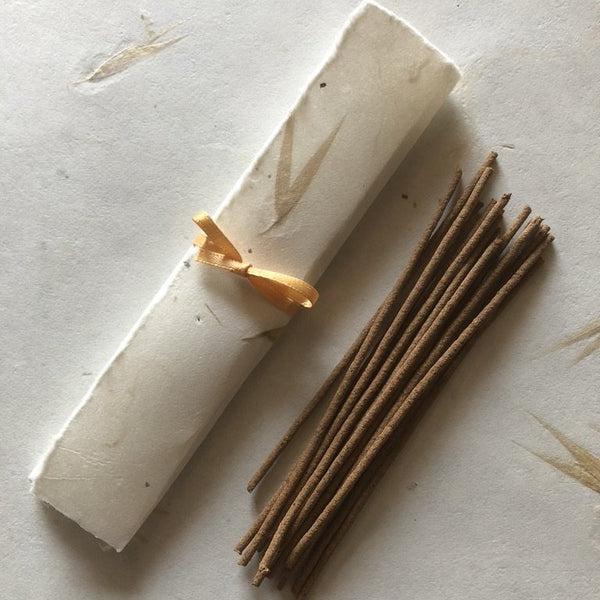Incense Sticks
At Ayala Moriel we produce two traditional incense sticks: Masala or Dhoop Sticks (which are coreless), and Agarbatti (Incense Sticks with Bamboo Core).
The core gives the incense stick durability during transport, and also a very accessible way to hold it upright wherever it may be required. Because of its unique aromatic makeup, Agarbatti tends to have a thick and lingering smoke, and also is slow to burn. You may even find that you'd like to put it out before it gets consumed on its own.
For those who prefer the purest incense (without any hint of the bamboo core), and have the appropriate ware, we recommend the cordless sticks. These are the most sophisticated incense blends are offered in this format. This incense shape requires a special vessel with the correct size hole to hold the stick in place, as well as receive its ashes. The most refined way to enjoy this type of incense, to the very last bit (which usually gets stuck and unburnt if placing it upright in a hole), is placing it horizontally inside a designated kodoh cup or in a bowl filled with fine ash. This ensure the stick burns in its entirety.
Another thing to keep in mind for this sticks, is that they break more easily. This is an advantage of course when wanting to portion them out and make them fit horizontally into any ash vessel. Another neat thing about incense sticks, is that they may be used for measuring time. They were used in such manners for many purposes, from telling time in general, with sophisticated incense that would change scent at certain time intervals. A practice we still use today is to frame a meditation practice with a certain scent that lasts a certain amount of time (most incense sticks burn from 20-60min) . What makes them perfect for meditation, is that they can be left alone to burn, being "low maintenance" during burning time; and also once the scent is over, one knows it's time to bring the meditation to a close.
-

Ayala Moriel Parfums
Ancestral Feast - Copal Incense
Sold out
Visit product page →Ancestral Feast was created especially for Day of the Dead to honour our ancestors with copal smoke. According to Mayan traditions copal is food for the souls and was not only burnt in funeral and memorial rites, but also shaped as meze or tamales to accompany the dead on their journey to the afterlife.
Incense cones, hand-rolled in the traditional techniqued, made from finely ground botanicals: five types of copal (Mayan, black, white, gold and Angolan), palo santo, white and red sandalwood and bound with natural gums or wood bark. No saltpetre or charcoal used in these cones.
Ancestral Feast Incense cones come in a box containing a dozen cones, or a paper-wrapped bundle of 18 incense sticks. Choose the form you prefer, and take note of the instructions below for burning each of them.To burn incense cones: Place the cone on a heat-proof dish or on a surface that you won't mind scorching (for example: a coin placed on top of a ceramic plate or tile; a ceramic bowl filled with sand, etc.), and away from any flammable materials, light the tip and blow off the flame. Allow to burn off completely.
To burn the incense sticks: Place the lit stick (light the tip and then blow out the flame) on a bowl full of ash (preferably rice ash). This will enable the stick to burn without any bits left off. If you have a designated incense dish with a hole you may also use that. It will leave a tiny bit of incense unused though.




